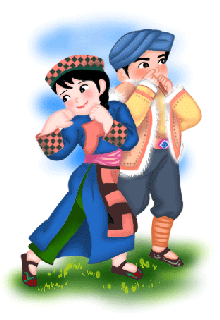
Dance performance
 |
|
The Qiang people
|
As mentioned above, the dancers wore a suit of armor during the Kasi Dawen Dance. The armor basically falls into four categories: armor made of lacquer ox hide, elephant skin, rattan and sheet iron. Among them, armor made of lacquer ox hide was most commonly used, and it can be subcategorized into whole-sheet armor and pieced armor, among which the latter was more widely used.
In E'en Village of Heishui County, the dance was performed on the oblong grain-drying yard which was 40 meters long and 20 meters wide. On one side of the yard were grain-drying shelves, on the other side, a valley, and the two left ends featured typical stone castles of Jiaorong Tibetans.
A dance usually took seven to eight minutes to complete and consisted of three basic parts. The first part was an introductory performance where 24 Tibetan men (two in armor and one in a red Tibetan otter hide robe) stood in a line -- the elderly and sainted ones to the left and the young ones to the right - armed with a knife or sword. A middle-aged man used an ox horn jug to pour a bowl of wine for the fighters going to battle, which was passed down from left to right. Meanwhile, an old man sprinkled wine from the bowl into the sky using his fingers while praying solemnly and loudly in Tibetan to show respect to the gods and to ask for protection. The whole process took about two to three minutes.
After the old man finished his prayer, the second part of the dance began and the procession proceeded clockwise, featuring the characteristics of Tibetan song and dance. Almost all Tibetan folk dances featured clockwise movements -- the same direction as Tibetans rotated the prayer wheel and walked aroundtemplesin their daily lives. Guided by the leading elder, the warriors in the dancing procession sang a sad, solemn song and now and then belted out: "Ou! … Ha!" at the top of their lungs. All the dancers sang and danced along the grain-drying yard, moving in quick, short steps with their backs in a half-bow, producing various primitive and typical Tibetan dance movements. In the third round, the procession neared its climax, with rising voices and faster movements. After two rounds of a snake-shaped procession inside the yard, the dance entered the third part, where the warriors' emotions and their yearning for the extinct national spirit were fully unleashed.
